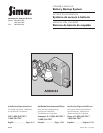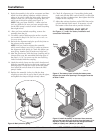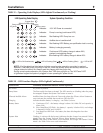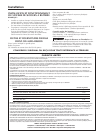
Installation 8
Excessive Battery Drain
Pump may have run for a very long time, discharging the
battery. In this case:
A) If 115VAC power is OFF, the charger shuts down
until the power comes back on, but the pump
will run as long as the battery charge lasts. You
may need to replace the battery afterwards.
B) If 115VAC power is ON, the charger/controller
continues to try to charge the battery at a
charging rate of .5 AH until the battery charge is
more than 20%, at which point the charger will
resume charging at a rate of 2 AH.
C) If the pump is running and the AC power is on,
you may need to stop the pump to allow the
battery to charge.
Pre-Qualification Test – 1 and 2
Charger is charging at a very low level to try to bring a
dead battery back to life. If the battery is taking too long,
try resetting the charger once or twice (push the ‘System
Test’ and ‘Silence Alarm’ buttons to reset the charger).
Special Features:
• The charger is equipped with reverse battery, short
circuit, and “run-away charge” protection.
BATTERY REQUIREMENTS
Hazardous electrical current. Can cause
severe burns and start a fire if the battery terminals are short
circuited. Install the battery in the battery case (See Key No.
12, Page 11). To prevent accidental shorting across battery
terminals, close and latch the battery case securely. Do not
leave the battery uncovered. Do not allow children to play
around the battery backup system installation.
Your backup sump pump depends on the battery used
with it for power. The better the battery, the better the
performance of the pump. We recommend the use of a
size 27M Marine Deep Cycle Battery. It will perform as
indicated in Table VI, on Page 10, and will stand up well
to long periods of little or no use.
This system is designed to work with a deep cycle
marine battery, either a flooded lead-acid battery or a
sealed maintenance free lead-acid AGM battery. Use of a
standard automobile battery with this charger is not
recommended. An automobile battery may require
charging after only 1–2 hours of continuous use, and the
repeated charging cycles may cause early plate failure in
the battery.
Use only the recommended battery or one of the same
type and size so it will fit in the battery box (maximum
size 13" long, 7" wide and 10" high [330.2mm x
177.8mm x 254mm] including terminals) and supply
enough voltage for full performance.
BATTERY MAINTENANCE
Severe burn hazard. An acid-filled standard
lead-acid battery contains sulfuric acid. Avoid contact with
skin, eyes or clothing.
NOTICE: To protect the battery case from chipping and
gouging, do not let the battery sit on a concrete floor.
Install the battery on a shelf or protective pad (plywood,
2x4s, etc.). Always install the battery in a dry location
that is protected from flooding.
Follow the battery manufacturer’s recommendations for
maintenance and safe use of the battery.
TROUBLESHOOTING
Pump won’t run.
1. Check all the wiring connections.
2. Check for a low or defective battery.
3. Check that the automatic switch is free to move up
and down.
4. Press the circuit breaker reset button on the control
panel.
Motor hums but pump won’t run:
1. Check for low or defective battery.
Pump runs but pumps very little or no water:
1. Make sure a check valve is installed and functioning
between the primary pump discharge and the Battery
Backup tee.
2. Check for an obstruction in the discharge pipe.
3. The discharge pipe length and/or height exceeds the
capacity of the pump. See Table VI, Page 10, for
pump capacity.
4. Check for a low or defective battery.
5. The Positive (+) and negative (–) pump wires are
reversed. Disconnect them and reconnect correctly.
Pump cycles too frequently:
The check valve located between the discharge of
the primary pump and the Battery Backup tee is not
installed or is not working properly. Install the auxil-
iary check valve (see Pages 4 and 5) or replace the
existing check valve as required.
For parts or assistance, call Simer Customer Service at 1-800-468-7867 / 1-800-546-7867
2 Amperes
130 Ampere Hours
2
130H
65H
80H
81.25 Hrs
Less than 84 hours to charge; OK to use.
2 Amperes
160 Ampere Hours
2
160H
100Hrs
Capacity too large – use a battery of 130A-H or less.
NOTE: A 100AH battery in good condition should charge
in approximately 62 hours.
Example 1:
Example 2:
5764 0108
TABLE I – Battery Capacity Calculation


















